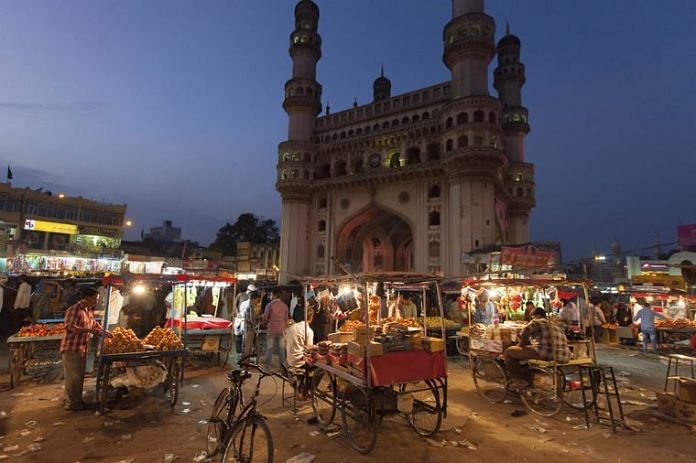The claim hinges on an apocryphal tale that a Muslim prince named the city after a Hindu dancer he was in love with, but historians say it is filled with holes.
Hyderabad: After a renaming spree in his home state, Uttar Pradesh Chief Minister Adityanath stoked controversy in Telangana by promising to rechristen Hyderabad as Bhagyanagar.
“Hyderabad will become Bhagyanagar as we did it in Uttar Pradesh, where we changed Faizabad to Ayodhya and Allahabad to Prayagraj,” Adityanath said at a rally in Nizamabad Wednesday.
In doing so, the Uttar Pradesh CM was playing on an old demand, these days championed by local BJP leader Raja Singh, who is known to be a rabble-rouser.
Those backing the move say that the city was first named Bhagyanagar after Bhagmati, claiming that she was a woman dancer who Mohammad Quli Qutb Shah, a ruler of Hyderabad, fell in love with, in the 16th century.
Historians, however, dismiss the theory as a “figment of the imagination” that does not have a “shred of evidence”.
“It is all fiction that Hyderabad was ever named Bhagyanagar or that it was named after the lover of Mohammad Quli Qutb Shah,” says Hyderabad-based historian Capt. Panduranga Reddy (retd), who has researched the city’s origins.
“Hyderabad was actually built much later around a small village called Chichulam.”
Also read: How Nehru and Yogi Adityanath differed on naming cities — from Chandigarh to Prayagraj
The lore
The apocryphal tale perpetuating the Bhagmati theory claims that when the city was founded by Mohammed Quli Qutb Shah in 1591, he named it after the dancer and singer with whom he had fallen in love with in his younger days.
“There are a lot of historical discrepancies that lead us to believe that it is just fictional,” says Capt Reddy. “There is a theory that Ibrahim Qutb Shah, father of Mohammed Quli Qutb Shah, built the famous Purana Pul (old bridge) where the young prince used to meet Bhagmati. But history records show that the bridge was built in 1578 and Mohammed Quli ascended the throne only in 1580, that too at the age of 14. So what would have been the dancer’s age?”
Another historian M.A. Qayyum agrees that the story of Bhagwati does not hold. “Hyderabad and Bhagyanagar have no connection. It has been created to fuel people’s imagination,” Qayyum said. “This idea gained traction in the early 1940s. People began adding their versions and it became folklore.”
Controversy attempt to push through Hindutva
Capt Reddy dismissed the controversy as just an attempt by certain groups to push through their ideology. “The controversy is part of a political agenda. Just because the CM from another state makes such a statement, it does not become true,” Capt Reddy said. “It does not change history.”
Hyderabad-based political analyst Jinka Nagaraj agrees this is just political.
“If you remove the name Hyderabad, it will antagonise the Muslim community. That is exactly what is being done,” he said. “They are trying to taunt Muslims and see their reaction and the repercussion. It is quite clear that they want some disturbance in Hyderabad.”
“Except for a few isolated terror attacks, Hyderabad has had no communal conflicts in the last three decades. So why create it now?” he asks.
Also read: We create a helpful map for Yogi Adityanath on which Muslim name to change next
The other story
While one set of historians dismiss the Bhagmati theory, there are others such as Narendra Luther who argue that there is documental evidence to prove “that she existed”.
To strengthen his argument, Luther mentions the existence of a property document in the Hyderabad archives department, which he says has been signed by a ‘Qazi of Bhaagnagar’.
Luther claimed that the lore of Bhagmati has been chronicled by several visitors, specifically three European travellers — Thevenot De Vernier, Manucci and Methwold — who, he says, wrote extensively about the danseuse.
“Even the court poet in Akbar’s court, Shaikh Abu al-Faiz ibn Mubarak, popularly known by his pen-name Faizi, wrote to Akbar saying that the ruler of Hyderabad was infatuated by an ‘old hag’,” he asserted.
Capt Reddy, however, completely dismisses this theory.
“After the area around Golconda Fort was faced with a plague epidemic, the entire township sought asylum near Chichulam. As people began settling around the area, they built several gardens and open spaces making it more of a ‘Baagh’ (garden) Nagar rather than Bhagyanagar,” he said.
“Walk around Hyderabad and you will see names such as Basheer Bagh, JamBagh and Baghlingampalli. That is how the name Bhagyanagar may have come up as a reference among travellers.”



